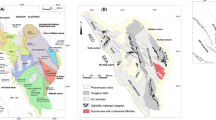Abstract
Fourteen vitrinite reflectance profiles from the Tarim Basin, NW China, show that the vitrinite reflectance profiles of individual wells follow a faulted and dislocated dual-stage pattern in the eastern section of the Tazhong Uplift and in the Tabei Uplift. Vitrinite reflectance values in these profiles change sharply at the unconformity beneath the Lower Carboniferous Bachu or Upper Devonian Donghetang Formations, where the overlying Triassic to Carboniferous strata are still in a mature phase within the “liquid oil window”. However, the underlying Lower Paleozoic reached the overmature phase beyond the “liquid oil window” towards the end of the Silurian, or in the Early Devonian at the latest. Whereas the vitrinite reflectance profiles are attributed to a continuous, single-stage pattern in the western section of the Tazhong Uplift, in which the Lower Paleozoic is also in an overmature phase, their overmaturity would have been achieved relatively late in geological time. The stratigraphic thermohistory has the following implications to regional geoevolution: (1) The overmature Lower Ordovician to Cambrian strata in the eastern section of the Tazhong Uplift and in the Tabei Uplift, as well as in the Manjiaer Depression, could not have acted as the source kitchen for normal oil (so-called black oil); (2) The dissimilarity in vitrinite reflectance profiles between the eastern and western sections of the Tazhong Uplift reveals Early Paleozoic paleotectonic features, i.e., lower at the east and higher at the west, whereas recent tectonic features formed since the Late Paleozoic are in reverse, i.e., higher in the east and lower at the west; (3) Reconstruction of the denuded thickness of sediments overlying the Lower Ordovician strata suggests reconsideration on the paleotectonic features in the Tarim Basin; (4) Based on the sustained duration of the “liquid oil window” for overmature source beds, it is predicted that the Suntuoguole Lower Uplift between the Awati and Manjiaer Depressions is a favorable potential source kitchen for Lower Paleozoic black oil.
Similar content being viewed by others
References
Buchardt B, Lewan M D. Reflectance of vitrinite-like macerals as a thermal maturity index for Cambrian-Ordovician Alum Shale, South Scandinavia. Assoc Amer Petrol Geol Bull, 1990, 74: 394–406
Dow W G. Kerogen studies geological interpretations. J Geochem Expl, 1977, 7: 79–99
Kisch H J. Incipient metamorphism of Cambrian-Silurian clastic rocks from the Jämtland Supergroup, central Scandinavian Caledonides, western Sweden: Illite crystallinity and “vitrinite” reflectance. J Geol Soc London, 1980, 137: 271–288
** K L. Organic Petrology-A Case Study of the Tarim Basin. Bei**g: Seismological Press, 1997. 285
Cheng D, Hao S, Wang F. Reflectance of vitrinite-like macerals, a possible thermal maturity index for highly/over-matured source rocks of the lower Paleozoic (in Chinese). Petrol Expl Dev, 1995, 22: 25–28
Zhong N, Qin Y. Organic Petrology Carbonate Rocks Characteristics, Origin and Evolution of Macerals with Respect to Hydrocarbon Generation (in Chinese). Bei**g: Science Press, 1995. 196
Wang F, He P, Chen D, et al. Take vitrinite like reflectance as the maturity indicator for Lower Paleozoic high-overmature source rock (in Chinese). Nat Gas Ind, 1996, 16: 14–18
Tong X. Geologic structure and petroleum accumulation. In: Tong X G, Liarg D G, eds. Paper Compilation of Oil and Gas Formation in the Tarim Basin (in Chinese). Urumqi: **njiang Science and Sanitation Press, 1992. 17–22
Jia C, Wei G, Yao H, et al. Tectonic Evolution and Regional Structural Geology (in Chinese). Bei**g: Petroleum Industry Press, 1995. 174
Lin C, Yang H, Liu J, et al. Paleostructural geomorphology of the Paleozoic central uplift belt and its constraint on the development of depositional facies in the Tarim Basin. Sci China Ser D-Earth Sci, 2009, 52: 823–834
Cai X, Kang Y. Formation and Occurrence of Palaeozoic Marine Petroleum in China (in Chinese). Urumqi: **njiang Science and Sanitation Press, 2002. 73–88
Kang Y, Kang Z. Tectonic Evolution and Oil and Gas of Tarim Basin (in Chinese). Acta Geosci Sin, 1994, (Z2): 180–191
Li M, Wang T, Chen J, et al. Paleo-heat flow evolution of the Tabei Uplift in Tarim Basin, northwest China. J Asian Earth Sci, 2010, 37: 52–66
Wang T G, He F, Wang C, et al. Oil filling history of the Ordovician oil reservoir in the major part of the Tahe Oilfield, Tarim Basin, NW China. Org Geochem, 2008, 39: 1637–1646
Author information
Authors and Affiliations
Corresponding author
Rights and permissions
About this article
Cite this article
Wang, T., Dai, S., Li, M. et al. Stratigraphic thermohistory and its implications for regional geoevolution in the Tarim Basin, NW China. Sci. China Earth Sci. 53, 1495–1505 (2010). https://doi.org/10.1007/s11430-010-4069-x
Received:
Accepted:
Published:
Issue Date:
DOI: https://doi.org/10.1007/s11430-010-4069-x




